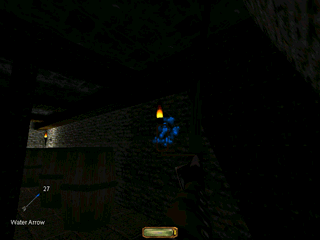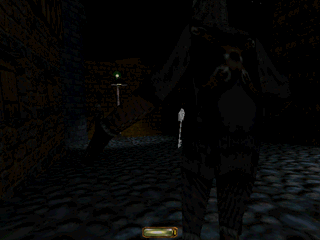Tips and Hints for the Thief: The Dark Project Demo
Playing Thief is unlike playing most other games, some of which
it may resemble at first. If you try to approach Thief the way you
did one of those other games, you might have some problems and miss out
on a lot of the fun of playing a thief. With that in mind, we offer a few
words to the wise ... underhanded, yes, but wise.
Sneaking
You may have heard the term "First Person Shooter" to describe other action
games with a first-person point of view. Thief is not one of those
games. Instead, think of Thief as a "First Person Sneaker." Sure,
you can use your sword and bow to kill your enemies, but the general rule
of engagement in Thief is: "The enemy should never know you were
there."
Of course, the best way to survive a fight is avoid it in the first
place. Pay attention to which way enemies are facing. Listen for their
footsteps. Choose dark places from which to observe their behavior. Notice
the type of ground you're walking on, and don't make lots of noise that
advertises your presence. Also, remember that you're harder to see while
crouching, when close to a wall, and without your sword or an arrow readied.
If you do need to take someone out, try sneaking up behind them and
knocking them out with a blackjack. Or try waiting in a shadow for an enemy
to walk past, and then shooting them in the back with an arrow. These options
are generally going to work better than a frontal rush.
Shadows
As a master thief, you have the ability to become practically invisible
while in shadows. If an enemy is otherwise ignorant of your presence, he
can pass quite close to you without seeing you, as long as you are in the
shadows.
The training mission will teach you that it's important to stay in areas
of darkness, and to avoid standing around in bright light if you can. What
it doesn't teach you is that, quite often, you can make your own darkness
by shooting out torches with water arrows. Don't underestimate the usefulness
of this technique!
 Garrett attacks his enemy ... a torch
Garrett attacks his enemy ... a torch
Watching
You will frequently have the opportunity to observe the behavior of enemies
who don't realize you are there. Watching your enemies can yield valuable
information for planning strategies to overcome them. For example, most
guards patrol along routes. By observing these guards
and learning their patrol routes, you can find the best opportunity to
sneak by them, pickpocket them, knock them out, etc..
Listening
In addition to using your eyes, be sure to use your ears. Thief
uses unique, sophisticated sound propagation technology. If you listen
carefully, you will be able to hear the footsteps, muttering, and whistling
of guards before you see them. You will also be able to listen in hallways
in order to determine which direction a sound is coming from and at doors
to hear when a guard has passed by.
Furthermore, the things guards say can have vital importance. If you
listen carefully, you will be able to determine whether a guard is oblivious
to your presence or if he suspects that he saw or heard you. You may even
hear guards talking among themselves as they coordinate to find or fight
you.
You really need sound to play Thief effectively. There's lots
of speech that is not subtitled, and if your speakers aren't turned on,
you won't hear it. Also, since the stereo location of sounds can be a very
important cue as to the positions of enemies around you, Thief will
benefit greatly from 3D sound technology such as A3D.
Pickpocketing
Guards will sometimes carry items such as keys and purses on their belts.
As a thief, you are capable of stealing these items without being detected.
In order to do so, simply highlight the target item and pick it up the
same way you would pick up any other item. Note that your pickpocket victim
must be unaware of your presence or your attempt will not succeed. Furthermore,
if you try to pickpocket someone who is aware of you but who does not think
of you as their enemy, be ready for them to change their mind!
 A guard about to lose his key
A guard about to lose his key
Combat
Engaging your enemies with your sword and bow is difficult for many reasons.
For one thing, your enemies may be as powerful as you. In many circumstances
trying to fight two or more foes at once can be fatal. You should be prepared
to take damage if you fight with your sword.
Furthermore, combat tends to ruin your stealth advantage. Other enemies
may become alert to your presence if they hear the sound of combat or if
your foe flees to find help. Most enemies will become
alarmed if they notice corpses and bloodstains left behind by combat.
Ambushing
In Thief you have the distinct combat advantage of being able to
ambush your foes. If your enemy is not aware of your presence, your
attack will do five times as much damage as it would
in face-to-face combat. Ambushing an opponent is often the safest
way to kill him.
Blackjacking
A good combat alternative to killing your enemies is to knock them out
by hitting them with your blackjack. You can blackjack anyone who can't
see you, even if they know that you are nearby. Thus
you can blackjack a searching guard from behind, or blind your foe with
a flashbomb and then blackjack him. In addition, non-combatants
such as servants can be knocked out with a blackjack even if they can see
you.
When you successfully blackjack a foe, he will immediately crumple to
the ground unconscious without crying out or leaving behind any blood.
Unconscious enemies do not wake up during the mission, but you should still
take care to hide their bodies. In addition to the blackjack, knock-out
gas (such as from gas mines) will render your foes unconscious.
Hitting a foe with the blackjack does a single
point of damage. If he is not knocked unconscious by the blow, it usually
only serves to make him mad. However, highly skilled players may use the
blackjack to slowly damage their foes until they flee. In rare cases
a blackjack attack on a very weak foe might accidentally kill him, especially
if it qualifies as an ambush.
Mantling
For those of you without a dictionary of climbing terminology, to mantle
is to pull yourself up onto a ledge. In Thief, you must stand in
front of the surface you wish to mantle, and then jump. But here's the
important part: you have to hold down the jump button until you're finished
mantling! We mention it because you might be used to doing this differently
in other games.
Also, be aware that there has to be sufficient space on top of the ledge
you're trying to reach. If you try to mantle and it doesn't seem to be
working, it may be because there's no room up there for you. If it really,
really looks like there's enough space, try adjusting your position slightly
and have another go.
Difficulty Levels
Each mission in Thief can be played at one of three difficulty levels:
Normal, Hard, and Expert. It's not an accident that we gave them these
names, and there's a good reason that we didn't call them "Easy, Normal
and Hard." Most players find that there's nothing particularly "easy" about
Normal Difficulty. Of course, if you're feeling up to the challenge, go
right ahead and play at Hard or Expert. Also (if
you purchase the commercial version of Thief so as to play the whole
campaign) remember that you can change difficulty levels between
missions. If you decide that some mission is too hard on a higher difficulty
level, you can restart the mission at an easier level. The Hard and Expert
difficulty levels will give you additional objectives for each mission
that were not available in Normal.
The Map and Compass
There are two navigational tools in Thief: the map and the compass.
Your map will be different for each mission, and the amount of detail they
show will vary, depending on how much you actually know about the place
you are infiltrating. When you look at the map, the general area you are
in will be highlighted in bluish-gray.
All of the maps are displayed with the top of the page facing north.
The compass (which you have in every mission) will turn as you move, so
that the red pointer is always facing north. Together, the map and compass
can often help direct you if you find yourself lost.